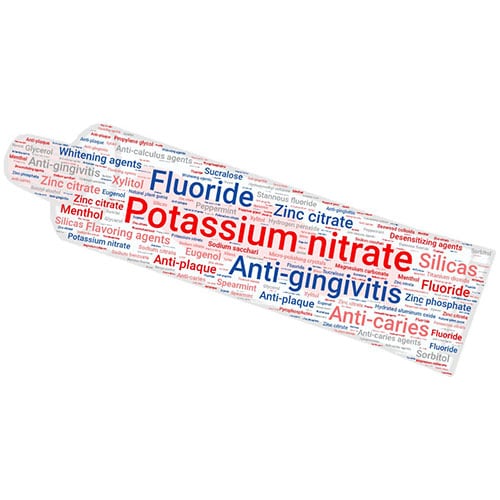As a dentist, you know the importance of a good toothpaste for your patients' oral hygiene routine. Yet, do you ever wonder exactly what’s in the tube and, more importantly, why?
Toothpaste is a complex formulation. In this article, we’ll discuss both the active and inactive ingredients of toothpaste, and we’ll explain how each one works to help you and your patients achieve your oral health goals.
Active ingredients
The active ingredients in toothpastes are those that are anti-caries, anti-plaque/anti-gingivitis and anti-hypersensitivity. Some toothpastes, such as Colgate Total, contain an active ingredient that is effective for all of these conditions, while other toothpaste may contain more than one active ingredient.
Anti-caries agents
Fluoride is a proven anti-caries agent, used in toothpaste to strengthen the tooth enamel and protect against demineralization. In early-stage caries, fluoride can also support the remineralization of the enamel and halt or even reverse the disease.
Fluoride is the only anti-caries agent accepted by the Food and Drug Administration (FDA). A toothpaste must also contain fluoride to gain the American Dental Association (ADA) Seal of Acceptance.
A toothpaste will contain one of several types of fluoride -- sodium fluoride (NaF), sodium monofluorophosphate (MFP), or stannous fluoride (SnF2). The percentage of the type of fluoride is listed on the label -- and the percentage varies by type to achieve the same ppm fluoride. So for example, a toothpaste would need to contain 0.24% sodium fluoride to deliver 1100ppm of available fluoride. To get the same amount of fluoride from stannous fluoride, it would need to contain 0.45% stannous fluoride.
Desensitizing agents
Multi-tasking stannous fluoride is also effective in relieving dentin hypersensitivity. Used as a desensitizing agent in products like Colgate Gel-Kam, stannous fluoride works by occluding the dentinal tubules with a tin-rich deposit, thereby preventing the fluid movement within the dentinal tubules that is associated with pain from sensitivity. This is the same mechanism by which Colgate Total relieves sensitivity.
Potassium nitrate, as found in the Colgate Sensitive range, is another commonly used desensitizing agent. It works by depolarizing the nerve cell and interfering with pain signals to the brain.
Anti-plaque/anti-gingivitis agents
These ingredients help to reduce biofilm (plaque) and gingivitis. Among the most common anti-plaque, anti-gingivitis agents are stannous fluoride and zinc citrate, both of which help to reduce biofilm and have a proven anti-gingivitis effect.
Inactive ingredients
If a toothpaste ingredient doesn't fall into one of the three active ingredient categories above, it is considered an inactive ingredient. Despite being called an inactive ingredient, these ingredients still play an important role in the effectiveness of toothpaste.
Anti-calculus agents
Anti-calculus agents prevent the calcification and hardening of biofilm accumulations on the teeth. Common anti-calculus ingredients are pyrophosphates and zinc citrate.
Abrasives
Abrasive agents in toothpastes help to gently remove biofilm and extrinsic (surface) stains from the teeth. Ingredients used for this purpose include calcium carbonate, silicas, hydrated aluminum oxide, magnesium carbonate, sodium bicarbonate and phosphate salts (e.g., calcium pyrophosphate). The ADA measures abrasivity using the Relative Dentin Abrasivity (RDA) scale, which compares the abrasivity of toothpaste to a standard reference value of 100. To be considered safe and effective, the RDA of a toothpaste must be at or below 2.5x the reference, or 250 RDA.
Detergents (surfactants)
The foaming action of toothpaste comes from detergent, AKA surfactant, most commonly sodium lauryl sulfate. The foam helps to aid the removal of biofilm and debris by loosening it through the foaming action, making it easier to brush away.
Whitening agents
Many whitening toothpastes rely on abrasive agents for extrinsic (surface) stain removal and/or ingredients that inhibit stain formation such as polyphosphates, while others use whitening ingredients like hydrogen peroxide or carbamide peroxide to help address extrinsic and intrinsic stain. Others feature a combination of agents, such as Colgate Optic White which contains hydrogen peroxide as well as micro-polishing crystals for extrinsic stain removal. A whitening effect with stain removal also occurs with Colgate Total, which contains zinc phosphate.
Anti-halitosis
These ingredients help to reduce halitosis (bad breath). One example is stabilized stannous fluoride.
Flavoring agents
Flavors are added to give toothpaste a more pleasant taste. Some toothpastes add menthol and oils like peppermint, spearmint, or eugenol for a minty flavor and fresh breath, while others use fruit flavorings.
Sweeteners
Toothpastes contain non-cariogenic sweeteners, like sodium saccharin, sorbitol, xylitol or sucralose. ADA-accepted toothpaste cannot contains cariogenic sweeteners, such as sugar.
Humectants
Humectants are added to toothpaste to prevent water loss and keep it moist. They commonly include sorbitol, xylitol, propylene glycol and glycerol.
Dyes
Dyes are added to toothpaste to improve its appearance. Food-grade dyes or natural dyes are used to color toothpaste. Plain white toothpaste gets its white color from titanium dioxide, which is not a dye but provides for opacity.
Binding (thickening) agents
Toothpaste is made from various ingredients. As the names suggests, and the binding/thickening agents help to bind together the ingredients, preventing the ingredients from separating and giving toothpaste a consistent texture. Common choices include natural plant gums (e.g. guar, xanthan), seaweed colloids (carageenan) and hydroxymethylcellulose.
Buffering agents
Buffers are added to toothpaste to keep the pH stable such that it is not too alkaline or acidic. Common buffering agents include sodium citrate, trisodium phosphate, and pyrophosphates (also used to prevent calculus formation).
Preservatives
Preservatives prevent microbial growth in toothpaste. The most commonly used preservative is benzyl alcohol, which can also function as a flavor enhancer. Sodium benzoate and methyl paraben are both preservatives that may be used in toothpastes.


Was this article helpful?
If you’d like a response, Contact Us.